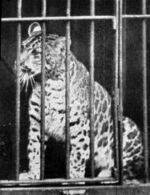MicrasWiki:Featured/August, 2020: Difference between revisions
mNo edit summary |
No edit summary |
||
| Line 1: | Line 1: | ||
[[File:Jingdaoese valleytiger.jpg|left|150px]] | [[File:Jingdaoese valleytiger.jpg|left|150px]] | ||
The '''Jingdaoese valleytiger''' (''Panthera jingdaoesis'') is a feline species that originates in south western Apollonia, where it lives almost exclusively in the territory of the [[Jingdaoese Empire]]. One feral group of the animals lives west of the [[Eventide Islands]] in Keltia, and another on the Great Plains to the north-west of [[Elam]]. It was the result of hybridisation experiments by [[Unit 666]] in 1681. Ancestors of the animal are, possibly among others, tigers from [[Xianbei]] (Kitanus Fields), and a [[Bijeko-Lisea-Nas|bijeko-lisea-nas]] from [[Corum]]. Goal of the project was to breed wild animals that are harmless to ethnic Jingdaoese citizens, but see others as prey. Results were moderately successful, with the animal still targeting minority groups such as Rivorians and Batavians. A group of 58 animals was released into the wild after funding for the project stopped in 1685. According to estimations, the population has since risen to 75 individual animals in the Tanlin and Zijinlin national parks. It is not sure how many are outside these territories, as the animals are considered to be mostly harmless and are not monitored | The '''Jingdaoese valleytiger''' (''Panthera jingdaoesis'') is a feline species that originates in south western Apollonia, where it lives almost exclusively in the territory of the [[Jingdaoese Empire]]. One feral group of the animals lives west of the [[Eventide Islands]] in Keltia, and another on the Great Plains to the north-west of [[Elam]]. It was the result of hybridisation experiments by [[Unit 666]] in 1681. Ancestors of the animal are, possibly among others, tigers from [[Xianbei]] (Kitanus Fields), and a [[Bijeko-Lisea-Nas|bijeko-lisea-nas]] from [[Corum]]. Goal of the project was to breed wild animals that are harmless to ethnic Jingdaoese citizens, but see others as prey. Results were moderately successful, with the animal still targeting minority groups such as Rivorians and Batavians. A group of 58 animals was released into the wild after funding for the project stopped in 1685. According to estimations, the population has since risen to 75 individual animals in the Tanlin and Zijinlin national parks. It is not sure how many are outside these territories, as the animals are considered to be mostly harmless and are not monitored. [[Jingdaoese valleytiger|More…]] | ||
<noinclude>[[Category:MicrasWiki:Featured|2020/08]]</noinclude> | <noinclude>[[Category:MicrasWiki:Featured|2020/08]]</noinclude> | ||
Latest revision as of 01:28, 1 August 2020
The Jingdaoese valleytiger (Panthera jingdaoesis) is a feline species that originates in south western Apollonia, where it lives almost exclusively in the territory of the Jingdaoese Empire. One feral group of the animals lives west of the Eventide Islands in Keltia, and another on the Great Plains to the north-west of Elam. It was the result of hybridisation experiments by Unit 666 in 1681. Ancestors of the animal are, possibly among others, tigers from Xianbei (Kitanus Fields), and a bijeko-lisea-nas from Corum. Goal of the project was to breed wild animals that are harmless to ethnic Jingdaoese citizens, but see others as prey. Results were moderately successful, with the animal still targeting minority groups such as Rivorians and Batavians. A group of 58 animals was released into the wild after funding for the project stopped in 1685. According to estimations, the population has since risen to 75 individual animals in the Tanlin and Zijinlin national parks. It is not sure how many are outside these territories, as the animals are considered to be mostly harmless and are not monitored. More…
